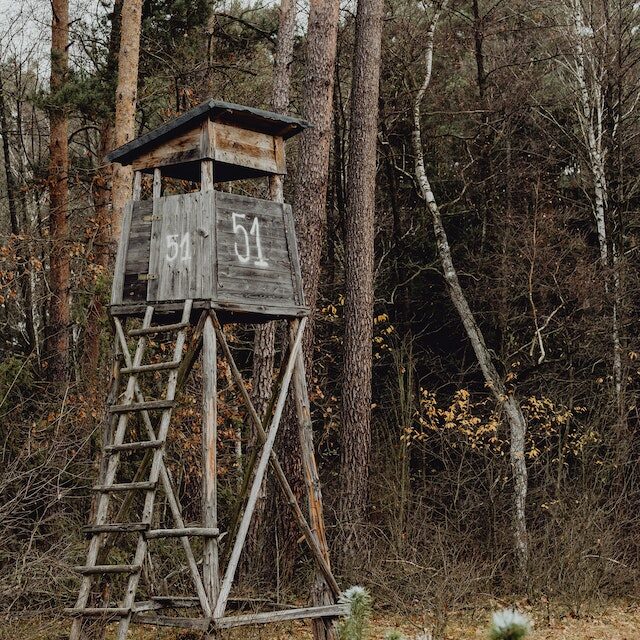Climbing Tree Stand vs Saddle: Which is Right for You?

Climbing trees has been a favorite pastime for generations. As technology and innovation advanced, so did the ways in which we take to the trees.
For hunters and nature enthusiasts alike, climbing tree stands and saddles have become indispensable tools. However, choosing the right one can be challenging.
In this article, we will compare climbing tree stands and saddles, exploring their pros and cons to help you make the best decision for your needs.
Why Should I Get A Climbing Tree Stand?
Climbing tree stands are elevated platforms that provide hunters and wildlife watchers with an unobstructed view of their surroundings.
They are typically composed of two parts: a seat and a platform that are attached to a tree using straps, cables, or chains. The user climbs the tree by alternately moving the seat and platform upward.
Comfort
One of the main advantages of a climbing tree stand is the level of comfort it offers. The seat and platform provide a stable and roomy space for sitting or standing, making it ideal for extended periods of use.
Many climbing tree stands come with padded seats and backrests to enhance comfort, while some even include additional features like armrests or shooting rails.
The spacious platform allows for greater freedom of movement, enabling users to stretch their legs and change positions without feeling cramped or constrained.
Setup
Climbing tree stands are relatively easy to set up, especially for those familiar with the process. Once you have chosen your tree, it takes only a few minutes to secure the stand in place.
This quick and straightforward setup process can be an essential factor for those looking to maximize their time in the field.
Most climbing tree stands also include built-in safety features such as locking mechanisms and adjustable straps, which can help ensure a secure and stable setup.
Elevation
Climbing tree stands allow for varying heights, giving hunters the advantage of an elevated vantage point.
This can help increase visibility and decrease the chances of being detected by wildlife. The elevated position also provides a better angle for shooting, as it allows hunters to shoot downward, reducing the likelihood of their shots being deflected by brush or other obstacles on the ground.
Why Shouldn’t I Get A Climbing Tree Stand?
Limited Tree Selection
Not all trees are suitable for climbing tree stands. The tree must have a straight trunk and no low-hanging branches, which can limit your options in densely wooded areas.
This constraint can be particularly challenging in regions where straight-trunked trees are scarce or in areas with diverse tree species, which may have unique growth patterns or branch configurations that are not conducive to climbing tree stands.
Weight
Climbing tree stands can be quite heavy, making them challenging to transport and set up. This can be a significant drawback for those who need to cover long distances to reach their hunting spot.
The added weight may also contribute to user fatigue, impacting overall performance and stamina in the field.
Some manufacturers offer lightweight climbing tree stands made from aluminum or other lightweight materials, but these options can be more expensive and may still be cumbersome for some users.
Noise
Climbing tree stands can generate noise during setup and while adjusting positions, which can alert nearby wildlife and potentially scare them away.
The sound of metal components rubbing against the tree or straps being tightened can travel a considerable distance in the quiet of the woods.
Some manufacturers have attempted to address this issue by incorporating sound-dampening materials and design elements, but noise remains a concern for many users.
Why Should I Get A Tree Saddle?
A tree saddle is a lightweight harness worn by the user, which is tethered to the tree using a rope or strap. To climb, the user ascends the tree with the aid of a separate climbing system, such as climbing sticks or a lineman’s belt.
Versatility
Tree saddles can be used on a wide variety of trees, including those with irregular shapes or low-hanging branches.
This makes them a more versatile option than climbing tree stands. The ability to use a tree saddle on virtually any tree increases the number of potential hunting spots and allows users to adapt to their environment more effectively.
Lightweight
Tree saddles are typically lighter and more compact than climbing tree stands, making them easier to transport and carry through the woods.
This reduced weight and size can be a significant advantage for those who need to cover long distances or navigate difficult terrain.
The compact nature of tree saddles also makes them more convenient to store and transport when not in use.
Stealth
Since tree saddles require minimal contact with the tree, they are less likely to generate noise during setup and use.
This can be advantageous for hunters looking to remain undetected by their quarry.
The low-profile design of tree saddles also allows users to blend more seamlessly with their surroundings, further enhancing their stealth capabilities.
By eliminating the need for a large platform, tree saddles minimize movement and reduce the chance of catching the eye of nearby wildlife.
Why Shouldn’t I Get A Tree Stand?
Comfort
Some users may find tree saddles less comfortable than climbing tree stands, especially during extended periods of use.
The lack of a stable platform can cause fatigue and discomfort, as users must rely on their core strength to maintain balance and position.
Additionally, tree saddles may create pressure points on the legs and hips, depending on the design and fit of the harness.
However, many modern tree saddles are designed with ergonomics and comfort in mind, incorporating features such as padding and adjustable straps to alleviate these issues.
Learning Curve
Climbing with a tree saddle requires a higher level of skill than using a climbing tree stand.
Users must be proficient with their climbing system, such as climbing sticks or a lineman’s belt, and comfortable with the saddle’s unique positioning.
This learning curve can be a barrier to entry for some users, particularly those who are new to tree climbing or less confident in their abilities.
However, with practice and proper instruction, most users can become proficient in using a tree saddle safely and effectively.
Exposure
Since tree saddles offer less concealment than climbing tree stands, users may be more visible to wildlife.
This can be mitigated by careful selection of tree cover and positioning, but it remains a consideration for those who prioritize stealth.
The lack of a solid platform may also make it more challenging to perform tasks such as using binoculars, rangefinders, or drawing a bow, as users must maintain their balance while executing these actions.
However, experienced tree saddle users often develop techniques to manage these challenges effectively.
Conclusion
When choosing between a climbing tree stand and a saddle, consider your specific needs and preferences. If comfort and a stable platform are your priorities, a climbing tree stand may be the better choice for you.
Climbing tree stands are ideal for those who plan to spend extended periods in the tree and appreciate the ease of setup.
On the other hand, if versatility and stealth are more important to you, a tree saddle could be the perfect fit.
Tree saddles are suitable for a wider variety of trees and tend to be quieter, making them an excellent option for hunters who need to remain undetected.
Additionally, their lightweight and compact nature make them more convenient for those who need to travel long distances through the woods.
It is also worth considering your experience and skill level when making your decision. If you are new to tree climbing or less confident in your abilities, a climbing tree stand might be a more suitable option due to its straightforward setup and use.
However, if you are an experienced tree climber and are comfortable with more advanced techniques, a tree saddle can offer greater flexibility and stealth.
Ultimately, the decision between a climbing tree stand and a saddle will depend on your personal preferences, needs, and skill level. By considering the pros and cons of each option, you can make an informed choice that will enhance your hunting or wildlife watching experience.
It may also be helpful to try both options before committing to a purchase. Many outdoor retailers and outfitters offer rental options or demonstrations, allowing you to test out each system and determine which one is the best fit for you.
Additionally, seek advice from fellow hunters or nature enthusiasts who have experience with both climbing tree stands and saddles. Their insight can be invaluable in making your decision.
In conclusion, both climbing tree stands and saddles offer unique advantages and disadvantages. By carefully weighing the pros and cons, you can select the option that best suits your needs, preferences, and skill level.
Whether you choose a climbing tree stand for its comfort and stability or a tree saddle for its versatility and stealth, the most important factor is that you enjoy your time in the great outdoors, connecting with nature and pursuing your passion.
